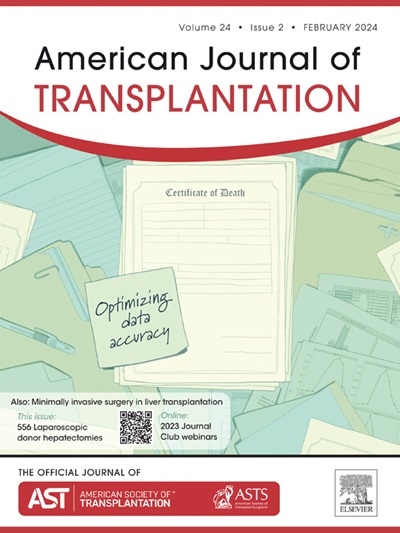Frailty in lung transplant recipients is associated with anemia and telomere dysfunction but independent of epigenetic age
IF 8.2
2区 医学
Q1 SURGERY
引用次数: 0
Abstract
Frailty is a syndrome of vulnerability to stressors linked to worse outcomes before and after lung transplantation. However, the biological basis of this association is unknown. Biological correlates of aging include epigenetic reprograming, chronic inflammation, telomere dysfunction, and anemia. We hypothesized that these aging-associated biological processes would be associated with frailty in lung transplant recipients. In a nested case-control study, we compared 43 lung transplant recipients who were frail pretransplant and posttransplant with 43 nonfrail matched controls. We quantified peripheral blood leukocyte epigenetic aging (Horvath) and longevity (GrimAge) clocks, telomere length, cytokine profiles, and hemoglobin before transplant. Epigenetic clocks were correlated with age but not frailty. However, we observed hypermethylation of multiple gene pathways, including hedgehog signaling and angiogenesis, and associated decreased levels of plasma cytokines in frail recipients. Frailty was also associated with telomere dysfunction and anemia. Overall, telomere dysfunction and anemia of chronic disease were most linked to frailty in this cohort, whereas epigenetic aging and chronic inflammation were not. Understanding the heterogeneity of aging syndromes may help target interventions in frail lung transplant recipients.
肺移植受者的虚弱与贫血和端粒功能障碍有关,但与表观遗传年龄无关。
虚弱是一种易受压力因素影响的综合征,与肺移植前后的不良结果有关。然而,这种关联的生物学基础尚不清楚。与衰老相关的生物学因素包括表观遗传重编程、慢性炎症、端粒功能障碍和贫血。我们假设这些与衰老相关的生物学过程与肺移植受者的虚弱有关。在一项嵌套病例对照研究中,我们比较了43名移植前和移植后体弱的肺移植受者与43名非体弱的匹配对照组。我们在移植前量化了外周血白细胞表观遗传老化(Horvath)和寿命(GrimAge)时钟、端粒长度、细胞因子谱和血红蛋白。表观遗传时钟与年龄有关,但与虚弱无关。然而,我们观察到多种基因通路的超甲基化,包括刺猬信号和血管生成,以及虚弱受体血浆细胞因子水平的相关降低。虚弱也与端粒功能障碍和贫血有关。总体而言,端粒功能障碍和慢性疾病贫血与脆弱最相关,而表观遗传衰老和慢性炎症则不是。了解衰老综合征的异质性有助于对虚弱的肺移植受者进行针对性干预。
本文章由计算机程序翻译,如有差异,请以英文原文为准。
求助全文
约1分钟内获得全文
求助全文
来源期刊
CiteScore
18.70
自引率
4.50%
发文量
346
审稿时长
26 days
期刊介绍:
The American Journal of Transplantation is a leading journal in the field of transplantation. It serves as a forum for debate and reassessment, an agent of change, and a major platform for promoting understanding, improving results, and advancing science. Published monthly, it provides an essential resource for researchers and clinicians worldwide.
The journal publishes original articles, case reports, invited reviews, letters to the editor, critical reviews, news features, consensus documents, and guidelines over 12 issues a year. It covers all major subject areas in transplantation, including thoracic (heart, lung), abdominal (kidney, liver, pancreas, islets), tissue and stem cell transplantation, organ and tissue donation and preservation, tissue injury, repair, inflammation, and aging, histocompatibility, drugs and pharmacology, graft survival, and prevention of graft dysfunction and failure. It also explores ethical and social issues in the field.

 求助内容:
求助内容: 应助结果提醒方式:
应助结果提醒方式:


